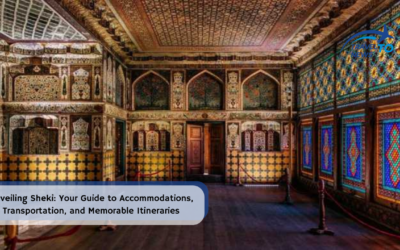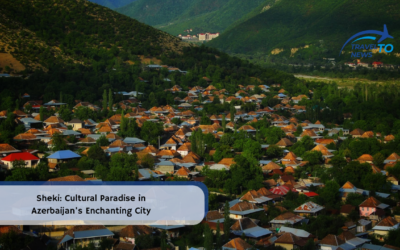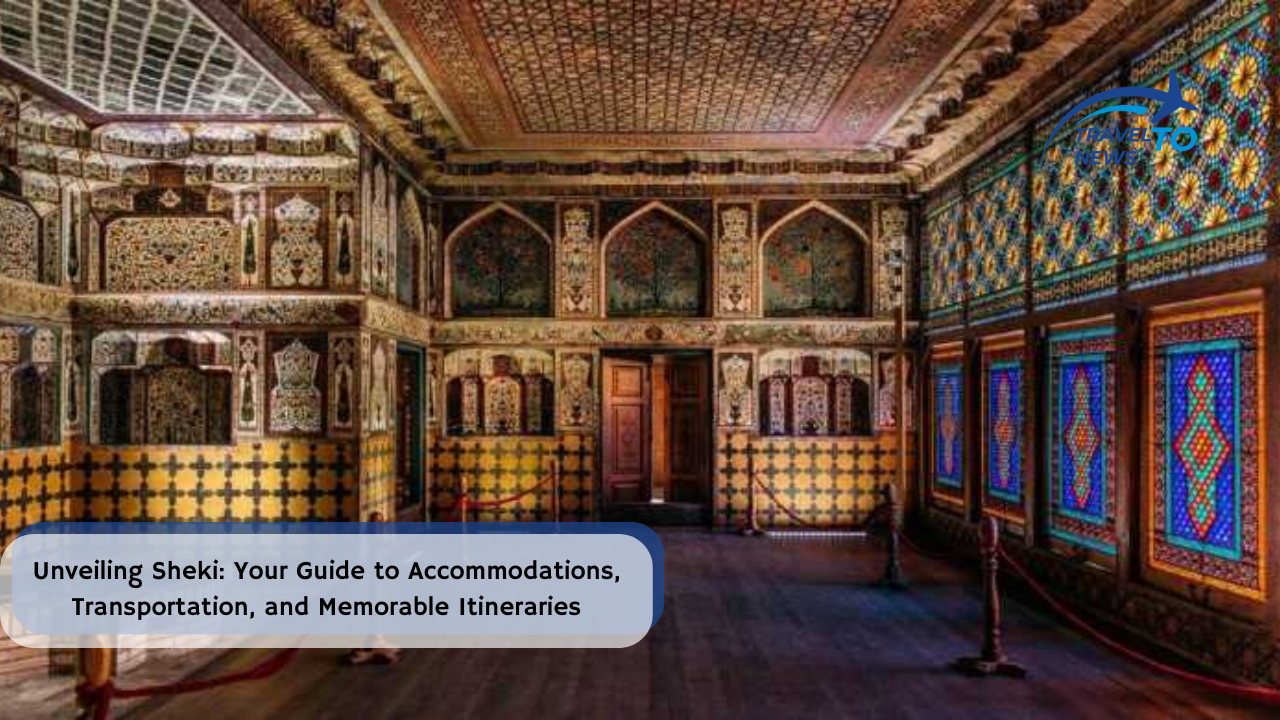Exploring the Wonders of Sahara Algeria: A Journey Through Time and Dunes
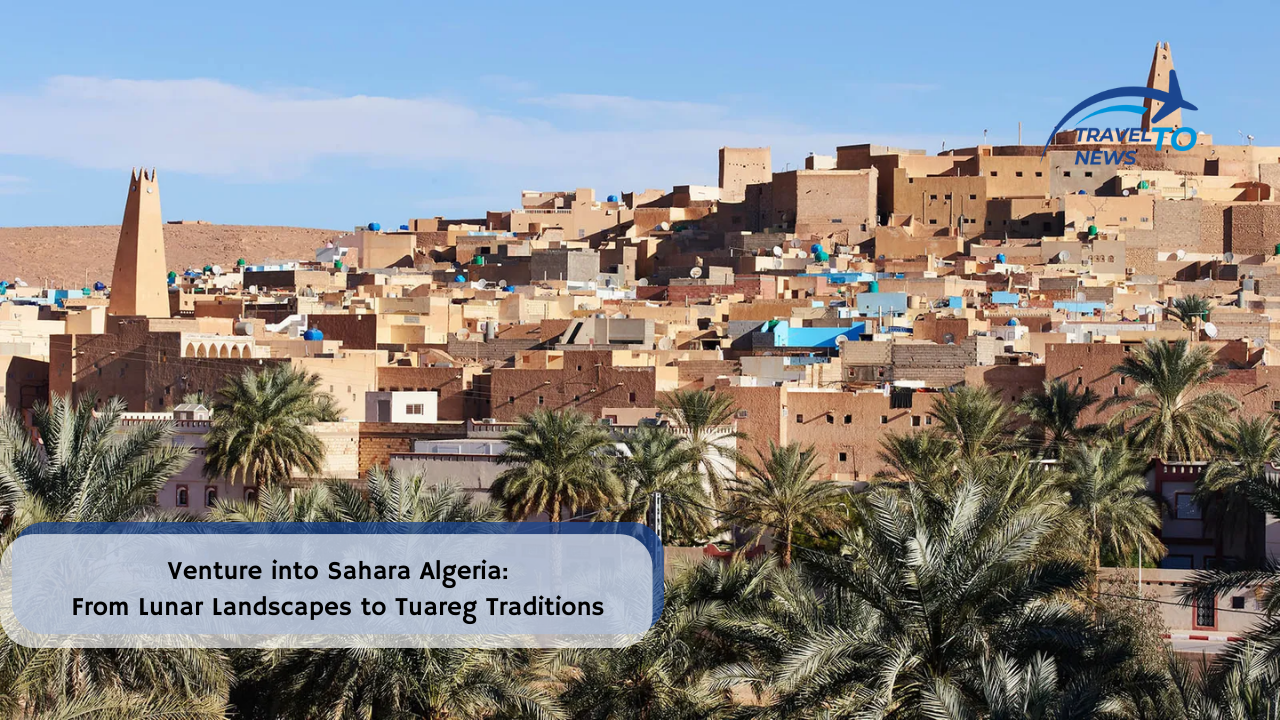
Embark on an unforgettable adventure into the Algerian Sahara. Our comprehensive guide unveils the desert’s secrets, from vast sand dunes to ancient cultures, ensuring your Sahara journey is nothing short of magical.
The allure of Algeria’s Sahara, the world’s most magnificent desert landscape, is hard to resist for any intrepid traveler. A realm of golden dunes and star-veiled nights, Sahara Algeria weaves a tapestry of timeless beauty and raw natural allure. This vast expanse of sand and sky, punctuated by rugged mountain ranges and verdant oases, stands as a testament to nature’s captivating paradoxes. But the Sahara is not merely a wilderness; it’s a place where ancient cultures and civilizations have silently blossomed over the millennia, leaving behind tangible echoes of their timeless existence.
Table of Contents
In the heart of this vast wilderness, compelling narratives unfold against the backdrop of colossal dunes and intricately carved rock formations. From the back of a camel or the window of a four-wheel drive, the drama of the desert comes into full view, offering a grand spectacle that seems to capture the very soul of Africa. Compelling in its starkness and unpredictability, the Sahara enthralls visitors who venture into its realm, offering an unforgettable voyage into the raw wilderness that could be both surreal and humbling.
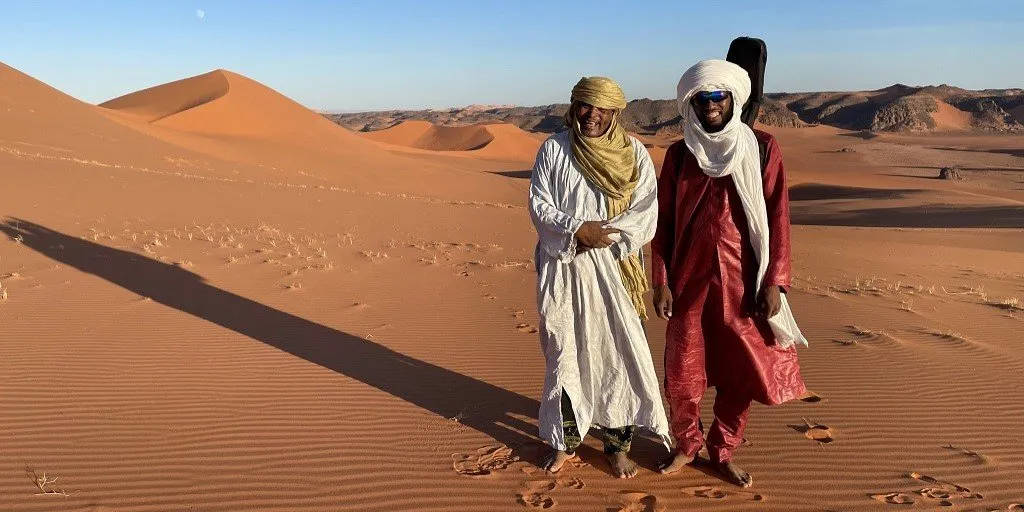
Whether you’re captivated by the notion of standing on the rim of an immense sand dune, enchanted by the idea of a night under the Saharan stars, or intrigued by the thought of discovering ancient rock paintings nestled in hidden canyons, Sahara Algeria has something for every adventurous spirit. The desert’s enduring allure lies not merely in its physical magnificence but in the spiritual journey it offers those who tread its sands.
In this comprehensive guide, we will embark on a journey to explore this majestic landscape and delve deep into its mystique. We will go beyond the jigsaw of golden dunes to unearth the rich tapestry of Saharan life, its diverse wildlife, and its cultural heritage. From desert survival strategies to secrets of the Berber and Tuareg nomads, we’ll offer an insider’s view of Sahara Algeria, making this guide an essential companion for your Saharan adventure.
Through a mosaic of historical accounts, anthropological insights, and firsthand experiences, we aim to bring the Sahara alive. We will examine how the desert has shaped the people who live amidst its sands and understand how it continues to exert a profound influence on their daily lives and centuries-old customs.
From practical travel advice to insights into the desert culture, flora, and fauna, our journey through the Sahara will equip you with invaluable knowledge and stories you’ll carry beyond the desert horizons. To the seasoned explorer or the curious traveler, our guide will illuminate Sahara Algeria in ways you’ve never imagined before.
So lace up your hiking boots, don your sun hat, and prepare to embark on an unforgettable journey into the mystique of Sahara Algeria – an odyssey that promises to enlighten, enchant, and inspire.
Embracing the Depths of Time and Space: Exploring the History and Geography of Sahara Algeria
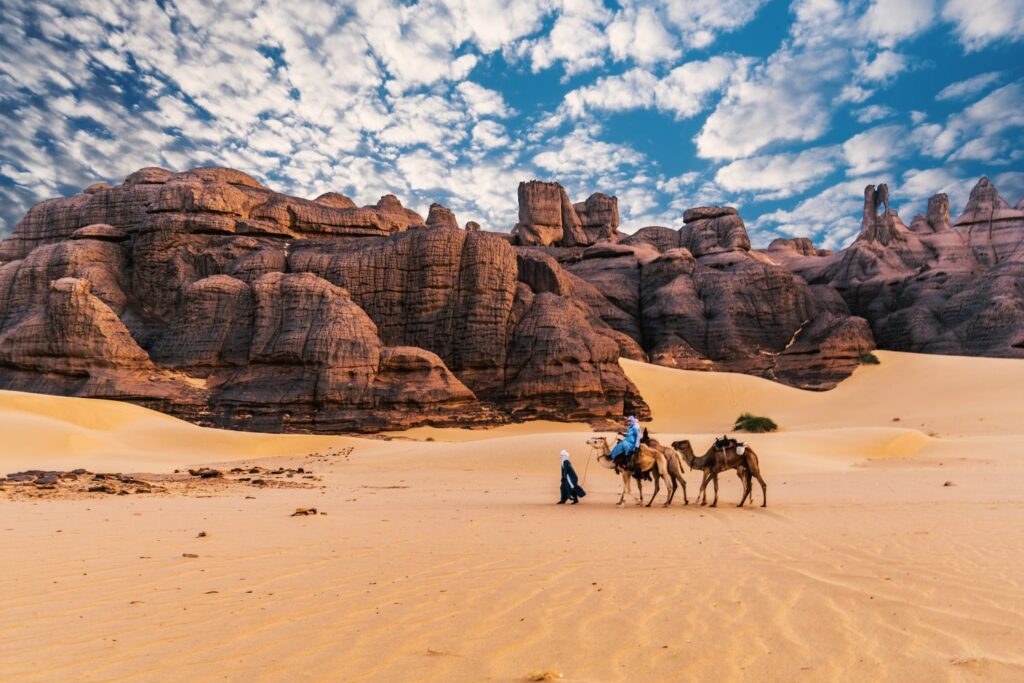
Veiled in the golden sands of Sahara Algeria lie captivating tales that stretch back millions of years into the unfathomable depths of time. From the formation of its breathtaking sand dunes to the ebb and flow of civilizations that have called this wilderness home, the Sahara’s past is as expansive and shifting as the desert itself. In this chapter of our comprehensive guide, we delve into the origins, geography, and climate of the Sahara, revealing the forces that have shaped its ethereal beauty.
From Sea to Sands: The Origin of the Algerian Sahara
Few visitors standing on the rim of a magnificent Saharan sand dune can imagine that 100 million years ago, their vantage point was covered by water. That’s right! The Sahara, in its geological infancy, was a seabed.
The transformation began during the Tertiary Period (66 to 2.6 million years ago), when tectonic forces caused the African and Eurasian continents to collide, resulting in the uplift of what are now the Atlas Mountains. As these mountains rose, they altered the region’s climate by creating a rain shadow, an area dry-land behind the mountain ranges that reduces precipitation.
With diminished rainfall, the land gradually eroded, giving birth to a harsh, arid environment. As time rolled on, the region’s transformation into an inhospitable desert picked up the pace. By approximately 2.5 million years ago, about the onset of the current geological epoch — the Pleistocene, the Sahara we recognize today was born.
A Canvas Carved by Nature: The Physical Geography of Sahara Algeria
The Algerian Sahara, often perceived as a vast, monotonous expanse of sand, is surprisingly diverse. It spreads over 2.5 million square kilometers, stretching from Algeria’s southern borders to the northern boundary with the Atlas Mountains. This sprawling wilderness oscillates between two extremes: the Grand Erg Oriental and the Grand Erg Occidental, comprising the endless sea of sand, and the breathtaking ruggedness of the Hoggar and the Tassili n’Ajjer mountain ranges.
The Ergs, giant seas of shifting sand dunes, some towering to heights of over 300 meters, epitomize the prototypical Saharan landscape in many minds. But they cover just a fraction of the Algerian Sahara. The quiet drama of the desert extends beyond these sandy realms to the plateau regions, known as Hammadas, flat stretches of stone and rock, devoid of sand and eerily silent.
Vying for the awe inspired by the sands are the Saharan mountains. From the volcanic peaks of the Hoggar Mountains to the bizzarely eroded sandstones of Tassili n’Ajjer, home to prehistoric rock art, these ranges lend the Saharan geography a touch of arresting contrast.
In matter of life sustenance, few, but precious, are the rivers traversing the Sahara, with a majority of them being ephemeral, only filled after infrequent rainfall events.
Unveiling the Veiled: The Climate of Sahara Algeria
The Sahara is the world’s hottest desert, and Algeria’s portion does not deviate from that label. Yet, its climate is as varied as its topography. Broadly classified, it falls under two climatic categories: the Saharan and the Sahelian.
The Saharan climate is characterized by extreme temperature variations, with scorching summers peaking over 50 degrees Celsius and plunging winter nights where the temperature can drop to freezing. Rainfall is incredibly sparse and unpredictable, with long periods of drought.
The Sahelian climate, on the other hand, is a transition between the arid desert and the more humid savannah. It experiences more rain than the Saharan climate, albeit erratically, and its temperatures are marginally less extreme.
Knowing the Sahara’s geography and climate helps you appreciate its resilient life forms and ancient cultures that have adapted to these stark conditions over millennia. As we journey deeper into Sahara Algeria, you’ll come to understand the intricate interplay between the land, climate, and life – both human and non-human, shaping the unique narrative of one of Earth’s most hostile yet hauntingly beautiful landscapes.
Today, Sahara Algeria continues to play out the drama of nature, etching its story in sand and stone, unfurling a magnificent canvas populated by unique flora and fauna, and punctuated by distinct emblems of humanity’s survival and spirit. Stay tuned as we embark on an exploration of this diversity in our upcoming chapters.
Amidst the Dunes and Dust: The Flourishing Biodiversity of Sahara Algeria
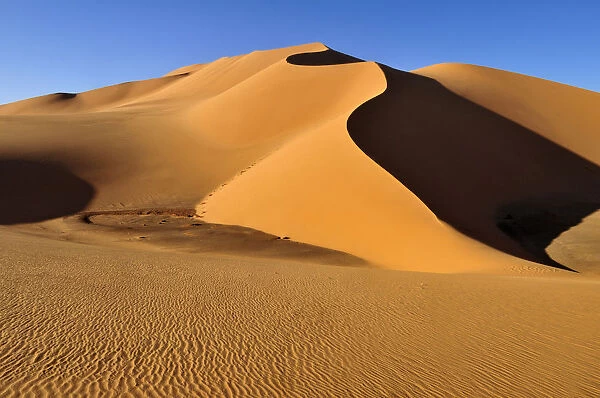
As we traverse the vastness of the Algerian Sahara, it’s not just the winds and sands that whisper stories of survival and adaptation. The desert, which at a casual glance seems empty and lifeless, is a vast stage for a breathtaking array of biodiversity. This chapter explores the unique flora and fauna that call Sahara Algeria their home and the tireless efforts to conserve this fragile ecosystem for future generations.
A Spectrum of Life in the Barren Plains
The Sahara may be renowned for its harsh, unforgiving terrain, but look closer and you’ll see the land throbbing with life. Among the resilient fauna, the Fennec Fox stands out as an icon of adaptability — its large ears not just distinctive but evolutionary marvels for dissipating heat. The Addax Antelope traverses the sands with grace, its wide hooves evolved perfectly for nomadic life on the dunes, while the Saharan Cheetah flits across the landscape, hauntingly scarce and beautifully adapted to a life of solitude and stealth.
Reptiles, with their remarkable ability to thrive in extreme conditions, are well represented here. The Horned Viper, a master of the sandy terrain, and the aptly named Saharan Uromastyx lizard, with its spiny tail, are testaments to the diversity of life that has flourished amid austerity.
The vegetation of the Sahara is no less remarkable. These plant species present an incredible study in survival. The Date Palm, yielding the fabled fruit, provides both sustenance and shade, a beacon of life in the sandy vastness. The tough, spiny Tufted Grass clings to existence in the shifting soils, while the miraculous Desert Thyme releases its fragrance into the arid air, remarkable for its ability to survive with such little water.
Navigating a Changing Landscape: Conservation in the Sahara
In the face of a climate that offers no quarter, human impact has added to the pressures on this delicate ecosystem. Poaching, habitat destruction, and climate change are the triple threats to the Sahara’s wildlife. The result has been a concerningly rapid decline in many species populations, a trend that, if not halted, could see the desert devoid of some of its most enigmatic residents.
Recognizing these challenges, governments, and conservation organizations have launched several initiatives to preserve the desert’s biodiversity. The establishment of protected areas, such as the Ahaggar National Park and the Tassili n’Ajjer National Park, offers a refuge where both flora and fauna can thrive. These areas not only safeguard biodiversity but also offer a glimpse into the desert’s prehistoric past, with rock art portraying wildlife that has roamed the region for millennia.
Research and monitoring continue to play vital roles in conservation efforts. Tagging programs for the highly endangered Saharan cheetah aim to track their dwindling numbers and better understand their range and behaviors. There are also breeding programs for species like the Addax antelope, aiming to eventually reintroduce these majestic creatures into their native habitats.
Local communities, too, play a crucial role, their traditional knowledge invaluable in the stewardship of the Sahara’s natural resources. Projects that involve local peoples in sustainable tourism and eco-awareness not only serve to protect the environment but also deliver economic benefits and empower those same communities.
A Future Written in Sand and Hope
The Algerian Sahara is much more than a barren wilderness — it’s a vibrant ecosystem where every grain of sand resonates with life. Our hope lies in our actions, and the sands of Sahara Algeria remind us that conservation is not a passive endeavor. It is a passionate, collective journey, a covenant with the future we must all partake in.
As the sun sets on another day of our Saharan narrative, we look to a horizon where man and nature coexist in respectful harmony. A future where the call of the desert fox is not just an echo of the past, but a living melody to guide us forward. Let us stay committed to preserving this remarkable tract of Earth, ensuring that the biodiversity of Sahara Algeria continues to thrive amidst its eternal dunes.
Whispers from the Sands: The Cultural Significance of Sahara Algeria
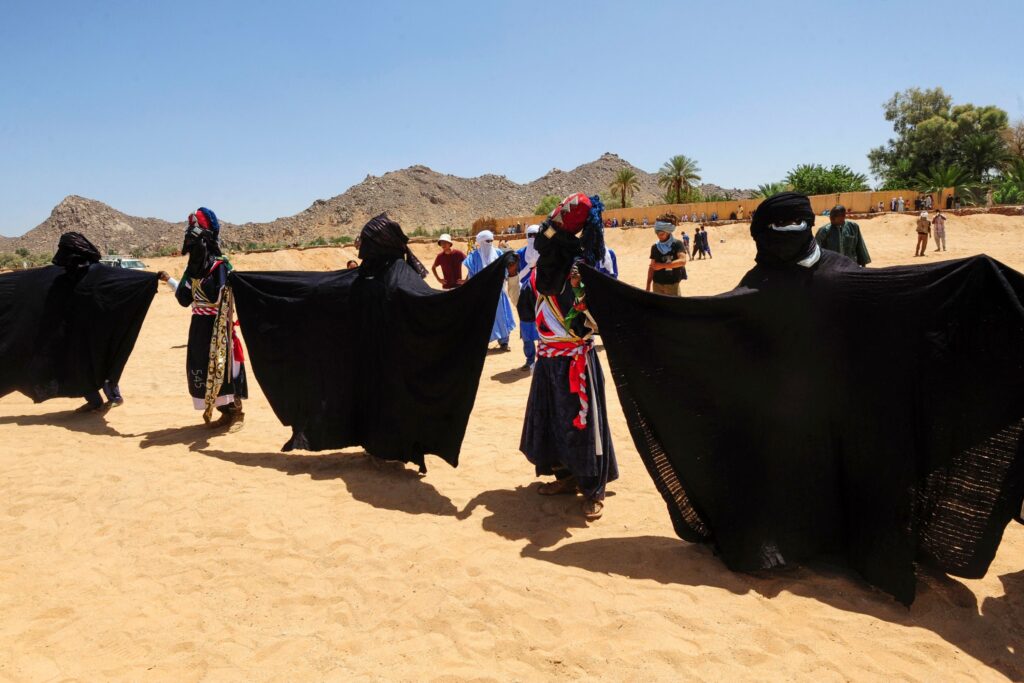
As the sultry winds of the Sahara caress its timeless dunes, they carry with them the weight of history and legend, of lives lived and stories weaving the past to the present. Set against the backdrop of this ethereal landscape, indigenous tribes and ancient rock art reveal the Algerian Sahara’s rich cultural tapestry. In this chapter, let us embark on a journey into the heart of this desert to appreciate not only its natural beauty but also its profound cultural significance.
Reflection of Stars on Earth: The Indigenous Communities of the Algerian Sahara
The rich, textured history of the Saharan sands is defined by the nomadic tribes who have wandered her vast expanses for generations. The Tuareg, affectionately dubbed the “Blue People of the Sahara” for their indigo-dyed clothing, are the region’s most iconic tribal group.
Their vibrant culture is steeped in legend and rooted in ancient oral traditions. Despite living in an unforgiving desert, the Tuareg have overcome challenges with intelligence and skill, traversing the desert using age-old knowledge of astronomy and navigation. The Tuareg’s social structure, emphasizing community and equality, has allowed them to adapt and survive in the difficult conditions of their timeless home.
As skilled traders, the Tuareg once dominated the trans-Saharan caravans, fostering cultural exchange and economic growth. Their fascinating heritage and customs pervade nearly every aspect of their lives, from the renowned Tinariwen music group, weaving electric melodies that resonate with the pulse of the desert, to the legendary Takoba sword, symbolizing nobility and strength.
A Gallery of Time: The Prehistoric Rock Art of the Algerian Sahara
Ancient secrets hidden in the parched embrace of the Saharan wilderness hint at the region’s prehistoric human inhabitants, painting an evocative narrative on time-worn stone. The most prominent examples of this archaeological wonder are found within the Tassili n’Ajjer National Park, a UNESCO World Heritage site known for its exceptional collection of prehistoric rock art.
Spanning more than 12,000 years of artistic and cultural evolution, these rock paintings and engravings offer a vivid account of Sahara’s environment, fauna, and human interaction. They reveal a time when the Sahara was a verdant paradise teeming with life, standing in stark contrast to today’s arid landscapes. Scenes of ancient pastoral life, wild animals, and enigmatic rituals are immortalized in a poignant reminder of our shared human past.
These faded masterpieces not only hold aesthetic significance but also serve as an invaluable archive of humanity’s early relationship with the natural world, presenting a timeline of climate, culture, and society through the millennia.
Preserving the Heart of the Algerian Sahara: A Cultural Legacy
The extraordinary cultural heritage of Sahara Algeria is a treasure to be cherished, as it speaks not only to the region’s inhabitants but also to us, echoing our interconnected human story. The preservation of indigenous customs, languages, and arts can inspire us to embrace the diversity that binds us together as we traverse the sands of time.
In celebrating the prehistoric rock art and archaeological finds of the Algerian Sahara, we not only pay our respects to our ancestors but also acknowledge the timeless bond between humankind and the natural world.
As we walk the paths traced by nomads, gaze upon ancient rock art, and share in the songs passed down through the ages, we find both solace and inspiration. The cultural heritage of Sahara Algeria reminds us of our shared humanity, our resilience, and our deep connection to the world in which we live.
Thus, as we continue our journey through the mystical expanse of the Algerian Sahara, may we carry these whispers from the sands within our hearts, reveling in the wisdom of the ancient and appreciating the indelible impact of the desert’s cultural tapestry—a legacy written not in sand but in the soul.
Jewels in the Sand: Major Reserves and Protected Areas of Sahara Algeria
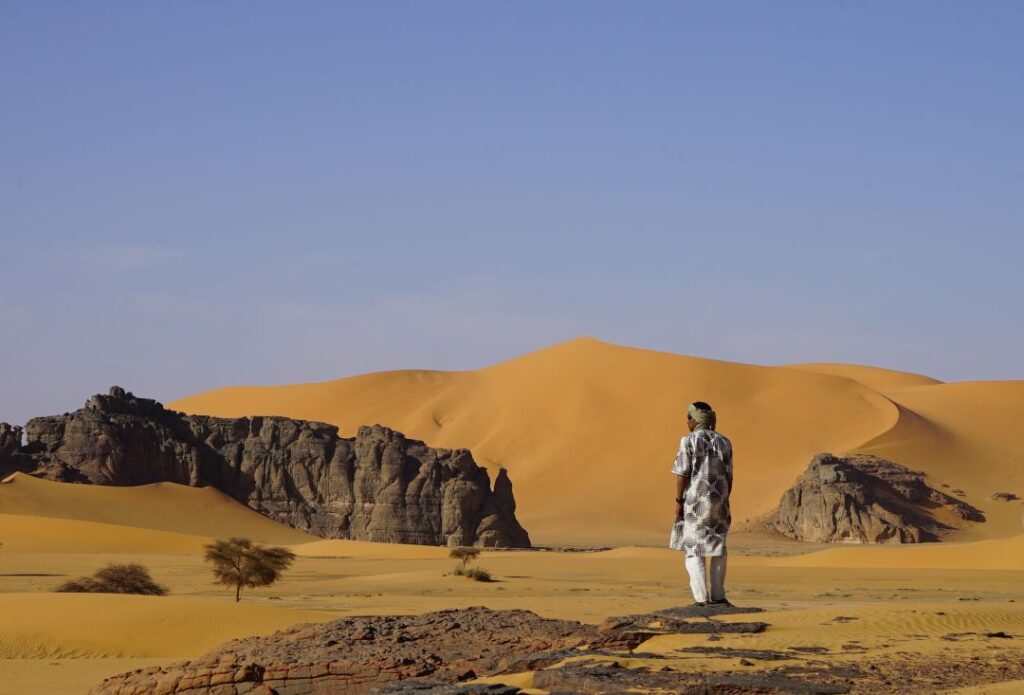
Immersed in the hypnotic allure of Sahara Algeria, we journey deeper into the heart of a landscape marked by extremes. This serenely hostile yet captivating wilderness is the perfect canvas for nature’s continuous drama. Enclosed within its wide sandy arms are spectacular reserves and protected areas that preserve the desert’s natural and cultural treasures. Let us wander into these breathtaking sanctuaries and discover the unique features that make them the jewels in the Saharan crown.
Tassili N’Ajjer National Park: A Window into Prehistoric Wonders
Stretching across the vast desert plateau in the southeast of Sahara Algeria, the Tassili N’Ajjer National Park is a UNESCO World Heritage Site bedazzled with natural and cultural wonders. Its spectacular sandstone rock formations, lush canyons, and mesas rise majestically, creating an almost otherworldly spectacle against the pure blue Saharan sky.
Carved into these weather-beaten rocks are more than 15,000 drawings and engravings that bear testimony to climatic changes, wildlife migrations, and the evolution of human life over at least two millennia. These ancestral masterpieces, ranging from large wildlife to depictions of daily life, offer a compelling glance into the Earth’s pulse throughout the ages.
Beloved for its biological significance, Tassili N’Ajjer also hosts several rare and endearing species, such as the Saharan Cypress and Saharan Myrtle – fascinating survivors of a bygone wetter age.
Ahaggar National Park: A Kingdom of Peaks and Legend
In the heart of the desert, southern Algeria, lies the Ahaggar National Park, a lacework of dramatic cliffs, deep gorges, and volcanic peaks. Known as the ‘Hoggar’, the park’s mountains tower over the surrounding desert, presenting a landscape as awe-inspiring as it is austere.
Home to the Tuareg people, the Hoggar is steeped in indigenous culture and folklore that echo across its windswept plateaus. Amidst its high peaks, including the towering Mount Tahat, highest point in Algeria, caves shelter precious prehistoric engravings and paintings.
The park also hosts a variety of resilient desert wildlife, including the endangered Barbary macaque and a variety of rare, desert-adapted flora. Undeniably, the Ahaggar National Park encapsulates the raw, untamed spirit of Sahara Algeria.
Other Noteworthy Reserves: Shelters of Life and History
Aside from these renowned national parks, Sahara Algeria embraces other lesser-known but equally important reserves.
The Ilizi-Ghadames Transboundary Protected Area, shared with Libya, protects a stretch of the Sahara’s raw beauty and unique biodiversity. Meanwhile, reserves like the Tademait plateau and Erg Chech safeguard their unique ecosystems, serving as vital habitats for unique desert flora and fauna and geological wonders.
One cannot ignore the Gouraya National Park and the Belezma National Park, located along the Atlas mountain ranges marking the boundary of the Sahara. These parks, although not part of the Sahara, contribute to the region’s environmental and cultural wealth with their distinctive biodiversity and historical significance.
A Symphony of Survival: Sahara Algeria’s Protected Areas
Sahara Algeria’s reserves and protected areas serve as custodians not just of biodiversity, but also of time — each a chapter in the stirring narrative of the planet. They are a testament to the enduring relationship between the land and its inhabitants.
Each park and reserve whispers a different tale. From ancient rock art and legends passed down among indigenous tribes to the thrilling spectacle of wildlife braving the odds in an unforgiving realm, these protected spaces in Sahara Algeria tell a timeless tale.
As we tread lightly through these dusty realms, admiring the wonders they cradle, let us remember to honor these regions as sacred links to our universal past and keys to our sustainable future. Whether under the watchful gazes of towering peaks or across the sun-drenched expanses of wind-kissed sand, the story of Sahara Algeria unfolds, sung by every whispering desert wind and engraved in every shifting dune.
Untamed Splendor: Embracing the Mystique of Tourism in Sahara Algeria
The Sahara Algeria sparks the imagination like few other places on Earth. Its vast dunes, rugged mountains, and starlit nights beckon the intrepid traveler in search of adventure and solace. Tourism in this magnificent region offers a portal into an ancient world of natural splendors and cultural wonders. If you’re considering choosing Sahara Algeria for your next unforgettable journey, let’s dive into the essential guide to making the most of your experience.
When to Visit: Timing Your Desert Dream
The ideal time to venture into Sahara Algeria is during the cooler months, from October to April. During this season, the temperatures are more pleasant, and the chance of experiencing a desert bloom increases, transforming the arid plains into fields of unexpected color.
Popular Activities and Experiences: Adventure Awaits
The Sahara’s vast wilderness offers an array of activities:
- 4×4 Dune Bashing: Thrash over towering dunes in a 4×4, leaving a trail of dust in your wake.
- Camel Trekking: Traverse the sands traditionally on the back of a camel, following ancient caravan routes.
- Cultural Encounters: Spend time with the Tuareg people, known for their rich culture and hospitality.
- Stargazing: The clear desert skies offer a canvas for some of the world’s best stargazing.
- Desert Camping: Overnight in a tented camp for the full Sahara experience, complete with traditional music and food.
Getting Around: Exploring with Ease
Venturing through the Sahara benefits from local knowledge. Most travelers opt for:
- Guided Tours: Experienced guides lead you to hidden gems and handle the language barriers.
- Rentals: Renting your own 4×4 is an option for those with desert driving experience.
- Domestic Flights: Fly over large distances to save time and then explore local areas by car or tour.
Why Visit Sahara Algeria?
A Journey Unlike Any Other
Sahara Algeria offers an escape to a world seemingly untouched by time. The landscapes are epic, the silence is profound, and the night sky is compelling. It is a destination that promises challenge, beauty, and tranquility.
Testimonials and Traveler Stories
Travelers often speak of transformative experiences, of landscapes that defy expectations, and of the warmth of the people. Many return with stories that feel like pages from a classic adventure novel, filled with the enormity of nature and the depth of human connections.
Sustainable Tourism: Traverse Mindfully
Sahara Algeria’s fragile ecosystems and traditional cultures require thoughtful tourism.
- Eco-friendly Travel Options: Choose tour operators committed to sustainability.
- Support Local: Buy local handicrafts and use local guides.
- Minimize Footprints: Stick to established trails and carry out all waste.
Impact of Tourism: Nurturing the Desert’s Future
Responsible tourism can provide vital revenue for conservation efforts and local communities. It’s important to ensure our visits contribute positively, supporting economic growth without exploiting resources or traditions.
Planning Your Trip: Essentials to Consider
Practical Advice
- Visas and Vaccinations: Check the latest visa requirements and health advice well in advance. Most travelers will require a visa and possibly vaccinations against diseases.
- Preparations: Pack protective clothing, sunscreen, and adequate hydration supplies for the harsh climate.
Tips on Where to Stay and Eat
- Accommodations: Options range from luxury desert resorts to traditional nomadic camps.
- Dining: Taste the region’s flavors in local eateries – try the tagines or grilled meats for a culinary delight.
Cultural Etiquette
- Respecting Traditions: Dress modestly and be sensitive to local customs, especially during religious observances.
- Photography: Always ask for permission before photographing people or their property.
The Sahara Algeria is not just a destination; it’s an immersive experience that cuts to the core of our wanderlust. It’s an opportunity to confront the vastness of nature, to appreciate silence and simplicity, and to connect with a way of life that has stood the test of time. Here, in the sea of sands, adventure awaits those ready to uncover the incredible tales nestled within the dunes.
The Radiant Horizon: Capturing the Essence and Spirit of Sahara Algeria
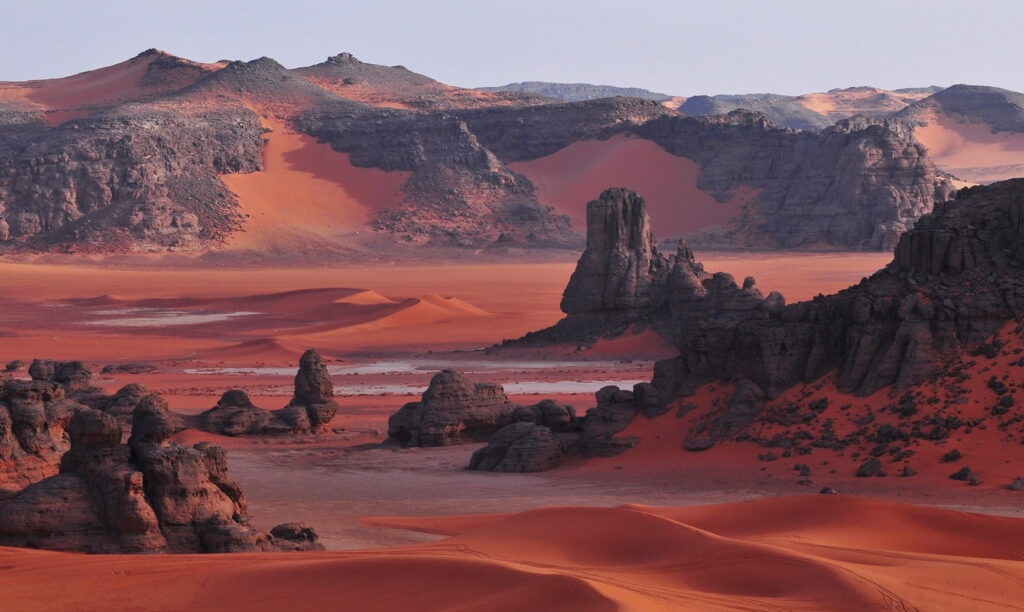
As we draw to the close of our virtual exploration of Sahara Algeria, we’re left with images of a desert painted with hues of gold, twilight’s purple shroud, and cultures embedded in deep tradition. Like a beautiful mirage that stays etched in our minds long after, Sahara Algeria too leaves an indelible imprint on those who visit.
The Soul of Sahara Algeria
Its vast landscape, though seemingly barren, thrums with a profound liveliness. The movement of the dunes, stirred by the wind, whispers tales of evolution and survival. This essence of the Sahara — anchored in change, resilience, and harmony — serves as a mirror for our life, reminding us of nature’s impermanence and the enduring spirit of humanity.
Its rich cultural heritage too beckons from every corner. The hospitable Tuareg communities, the ancestral rock arts, and the tantalizing flavors of Algerian cuisine tie together threads of history, culture, and life in an endearing tapestry unrivaled elsewhere. No visit to Sahara Algeria is complete without embracing these vibrant fragments of its soul — its people, their traditions, and their way of life.
Final Tips for Making Your Visit Memorable
To make your journey to Sahara Algeria a truly unforgettable episode in your life’s travelogue, here are some final tips:
- Keep an Open Heart and Mind: Be ready to embrace the unexpected. The relentless sun, shifting sands, unforeseen challenges are as much a part of the desert experience as the tranquil nights and cultural interactions.
- Absorb, Don’t Rush: Don’t try to conquer, but be conquered. Revel in the awe-inspiring landscapes and let the tranquility of the desert sink into your being.
- Engage with the Cultural Heritage: Take time to understand, respect, and engage with the local culture — it will enrich your journey with a deeper perspective.
- Document Your Journey: Photos and journals are wonderful keepsakes to remember your desert dreams. However, ensure any form of documentation respects people’s privacy and the desert’s serenity.
- Reflect on your Experience: Returning from Sahara Algeria will elicit new insights about yourself and the world. Dedicate time to reflect on these to truly reap the benefits of your journey.
Every grain of sand in Sahara Algeria tells a story — of resilience, of time, of silent wisdom. While you roam the dunes and dwell under the stellar sky, remember that you are a part of this timeless narrative. Let the desert weave its magic around you. As you head back home with pockets full of golden dust and a heart full of vibrant memories, may the spirit of Sahara Algeria continue to shimmer in your soul, like a sweet serenade that echoes in the chambers of time and life.



